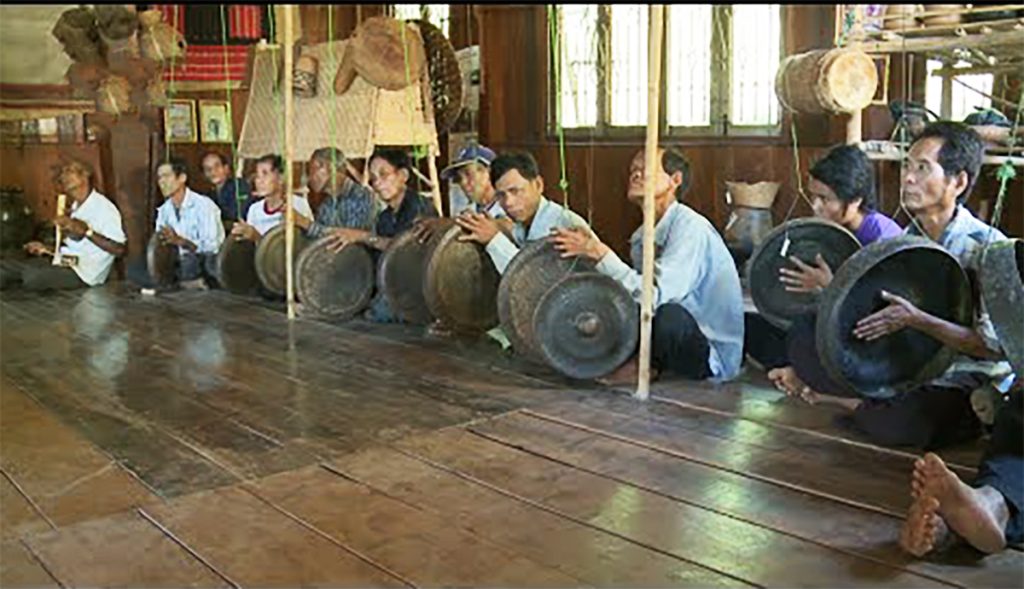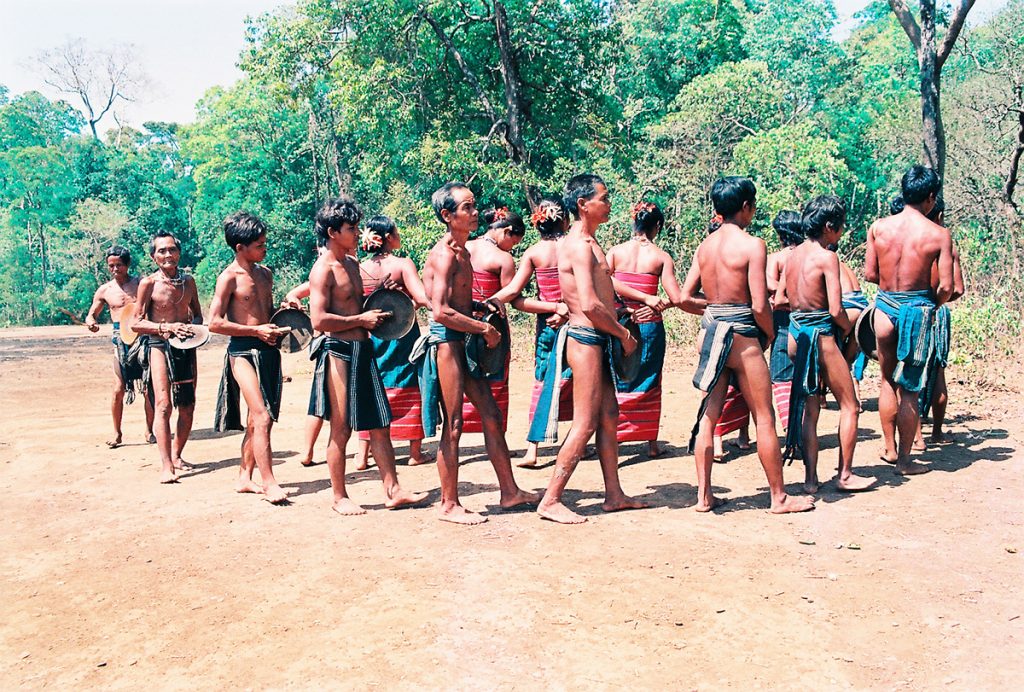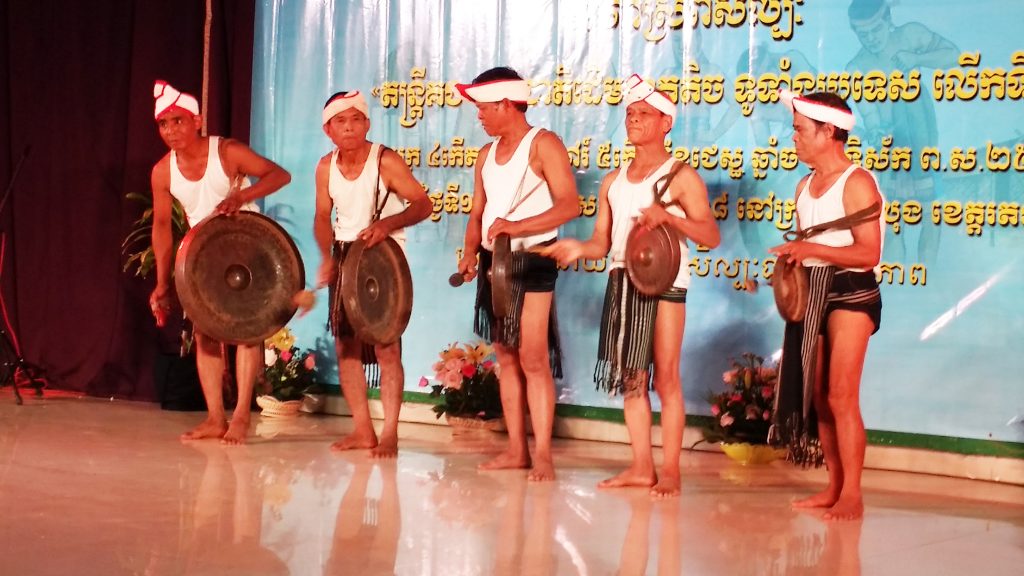ទស្សនៈ «សិល្បៈជាកញ្ចក់ឆ្លុះសង្គម» ឆ្លុះបញ្ចាំងពីរបៀបរៀបរយនិងសកម្មភាពសហគមន៍រួមរបស់ជនជាតិ រួមទាំង «ភូមិមូល» ដែលជាទីកន្លែងនិងទីលានដែលគេរស់នៅជួបជុំ ប្រារព្ធពិធីដែលមានរបាំនិងតន្ត្រី ដើម្បីពង្រឹងនូវស្មារតីសហគមន៍និងផលប្រយោជន៍រួម ក៏ដូចជាសុវត្ថិភាពនិងសុខដុមភាពសង្គម។
ពាក់ព័ន្ធនឹងឧបករណ៍និងវង់តន្ត្រី ឧបករណ៍ធ្វើពីឫស្សីនិងឈើ ច្រើនប្រើនៅក្នុងបរិបទក្រៅសាសនា ចំណែកឯឧបករណ៍ធ្វើពីដែកនិងស្ពាន់ មានគងពីរ បី ប្រាំ ប្រាំពីរ ១២ និង១៣ផ្លែ ប្រើនៅក្នុងបរិបទសាសនា។
ទំនាក់ទំនងរវាងបុគ្គលនិងសហគមន៍ទៅនឹងព្រលឹងអារក្ខអ្នកតា គឺជារឿងមួយដ៏សំខាន់ក្នុងការធានាបាននូវសុវត្ថិភាពនិងសុខដុមភាពសង្គម។ នៅក្នុងន័យនេះ ជនជាតិរៀបចំប្រារព្ធ «ពិធីសែនគង» មុននឹងគេយកគងមកសម្តែងនិងផឹកស្រាដឹកនាំដោយមេកន្ទ្រាញ មេភូមិ ឬចាស់ទុំក្នុងសហគមន៍ ដូចយើងបានឃើញនៅក្នុងចំណោមជនជាតិព្រៅនិងកាវ៉ែតក្នុងខេត្តរតនគិរី។

វង់គងពីរផ្លែរបស់ជនជាតិព្រៅ ហៅថា ហ្កងថាច ឬ កាពីងតាក់ម៉ឺត (គងធំ កាពីង = ប្តី, គងតូច តាក់ម៉ឺត = ប្រពន្ធ)។ គេក៏មានតំណមខ្លះក្នុងការប្រើបប្រាស់គងនេះ។ គេប្រើគងនេះនៅក្នុងឱកាសផ្សេងៗ ដូចជាអាពាហ៍ពិពាហ៍ សែនភូមិ កាប់ក្របី ផឹកស្រា ឬសព ជាដើម។ បញ្ជីបទដែលគេសម្តែងជាមួយវង់គងពីរផ្លែមាន៖ តាឡាក់តាវឡា សម្រាប់ឡើងផ្ទះថ្មី កាប់ក្របី និងពិធីផ្សេងៗទៀត, តាកឡាក់ចេញ សម្រាប់ឡើងផ្ទះថ្មី កាប់ក្របី និងពិធីផ្សេងៗទៀត, តាក់ឡូងចិត្ត សម្រាប់ឡើងផ្ទះថ្មី និងអាពាហ៍ពិពាហ៍។
វង់គងប្រាំផ្លែរបស់ជនជាតិកាវ៉ែត មានឈ្មោះថា ហ្កងឈើង ឬហ្កងប៉ាច ឬហ្កងជីង ដែលគេប្រើនៅក្នុងបរិបទផ្សេងៗដែរ ដូចជាពិធីផឹកស្រា អាពាហ៍ពិពាហ៍ និងចំណងមិត្តភាព។

នៅក្នុងចំណោមជនជាតិព្នងនៃតំបន់តាកុកព្នង ជាប់នឹងព្រំប្រទល់ប្រទេសវៀតណាមប៉ែកខាងឦសានប្រទេសកម្ពុជា ក៏មានវង់គងមួយចំនួននិងចាប៉ីឃ្លោកខ្សែ៨ ហៅ ហ្កងរីងដែរ។ នៅកម្ពុជា គេឃើញមានចាប៉ីឃ្លោកនេះនៅក្នុងចំណោមជនជាតិភាគតិចមួយចំនួន ដូចជា៖ ព្នង ហ្កងរីង, ទំពួន ហ្កងទឹង, គ្រឹង ជីងរៀង, ច្រាយ ប៉ាសទូង, កាចក់ ហ្កងកាដេះ, និងព្រៅ ប្រួក។ ចាប៉ីឃ្លោកទាំងនេះ សម្តែងដោយបុរសនៅក្រោមពន្លឺព្រះច័ន្ទជាការកែកម្សាន្តក្នុងចំណោមក្រុមបុរសនិងស្ត្រី។
គេសម្តែងវង់គងប្រាំពីរផ្លែ ហៅថា ខ្នាសកាក់ខ្នាសយ៉ាង នៅពេលកាប់មាន់ឬក្របីនិងផឹកស្រា។ នៅក្នុងចំណោមជនជាតិគ្រឹង គេប្រើវង់គង១២ផ្លែ ហៅ ហ្កងជីង (គងញី និងគងឈ្មោល) សម្តែងដោយបុរសសុទ្ធនៅក្នុងពិធីផ្សេងៗ ដូចជាចូលឆ្នាំ សែនព្រលឹង សែនស្រូវទុំ កាប់ក្របី សព ឬក៏គ្រាន់តែជួបជុំគ្នាផឹកស៊ី រាំលេងសប្បាយរីករាយធម្មតា។ ជនជាតិគ្រឹងមិនអាចរស់នៅដោយគ្មានវង់គងឡើយ។ គេតែងតែឮសូរសំឡេងគងនៅក្នុងគ្រប់ការជួបជុំគ្នានិងគ្រប់ពិធីទាំងឡាយ។ ក៏មានន័យថា ជនជាតិគ្រឹងមិនមានតំណមអ្វីពិសេសដែលថាមិនឱ្យប្រើគងទាំងនេះឡើយ។ គេក៏ដឹងថាពិធីនីមួយៗជាពិធីអ្វីទៅតាមបទដែលគេសម្តែង។

របាំជនជាតិលាតត្រដាងពីការវិលជុំនៃភូមិស្ថានរបស់គេ មានការកាប់ឆ្ការនិងដុតចម្ការ ដាំដុះនិងច្រូតកាត់ ការផ្លាស់ប្តូរលំនៅស្ថានពីភូមិចាស់ទៅនៅភូមិថ្មី ឬរាំវង់ភូមិថ្មី។ ដូច្នេះ យើងក៏អាចសន្មតថាជីវិតជនជាតិភាគតិច ស្ថិតនៅជុំវិញជំនឿអរូបី ពិធី ផឹកស្រា និងគ្រួសារ។ សកម្មភាពសហគមន៍ ឆ្លុះបញ្ចាំងពីស្ថានភាពសេដ្ឋកិច្ចសង្គម រួមមានការដាំដុះនិងច្រូតកាត់ ការសាងសង់ផ្ទះ ឬជីកព្រែកប្រឡាយរួមគ្នា។ ជាមួយគ្នានេះដែរ គឺគេលេងភ្លេងជាក្រុម ដែលជានិមិត្តរូបបង្ហាញពីស្ថានភាពសហគមន៍និងគោលបំណងរួមតែមួយព្រមទាំងសាមគ្គីភាពជាក់ច្បាស់នៅក្នុងបរិបទសង្គម និងវប្បធម៌របស់គេ។ ក៏ដូចគ្នាដែរសហគមន៍ សង្គម ប្រវត្តិសាស្ត្រ និងវប្បធម៌ តន្ត្រីជនជាតិភាគតិចខាងលើ មានការផ្លាស់ប្តូរនិងវិវត្តទៅតាមពេលវេលានិងកាលៈទេសៈ ជាពិសេសនៅក្នុងបរិបទ សកលភាវូបនីយកម្ម បន្ទាប់ពីមានការហូរចូលមកនូវវប្បធម៌ប្រជាប្រិយ ទំនាក់ទំនង ជាមួយទីក្រុង លក្ខណៈប្រពៃណីមួយចំនួនមានការប្រែក្លាយនិងបាត់បង់។ យុវវ័យជនជាតិខ្លះ ក៏បោះបង់ចោលនូវទំនៀមទម្លាប់ប្រពៃណីរបស់ខ្លួន ហើយចាប់យកប្រពៃណីនិងវប្បធម៌ថ្មីវិញ។ ជាការពិតណាស់ ដែលគេមានការពិបាកក្នុងជម្រើសរវាងអភិវឌ្ឍន៍សេដ្ឋកិច្ចសង្គមនិងការថែរក្សាប្រពៃណី ពោលគឺ «ថាស្រួលជាងធ្វើ»។ ជំនួសវង់គងដោយអ៊កកាដង់ ឬការ៉ាអូខេ ជាឧទាហរណ៍ជាក់ស្តែងដែលកើតមាននៅក្នុងចំណោមជនជាតិភាគតិច ក៏ដូចជាសង្គមខ្មែរទូទៅដែរ។ ទស្សនៈ ការទទួលយក និងការអនុវត្តលើអត្តបុគ្គល ភាពជាតារា មនុស្សធម៌ទាប និងការធ្វើឲ្យអស់ឬឱនថយនូវភាពជាមនុស្ស បញ្ជាក់ច្បាស់ពីភាពផ្ទុយគ្នាស្រឡះរវាងអតីតកាលនិងបច្ចុប្បន្នកាល បុរាណនិងសម័យ ក្រុមនិងបុគ្គល ព្រមទាំងការសង្កត់ធ្ងន់ទៅលើគំនិតនិងទស្សនៈ «យើង» ជាង «ខ្ញុំ» ក៏ដូចដែលសិល្បៈឆ្លុះសង្គម ដូច្នោះដែរ៕
——————————
Art Reflects the Society: Music in the Lives of the Indigenous Ethnic Groups
The indigenous ethnic groups, inhabiting the hilly plateau in the northeast of Cambodia, are also known as the Montagnard (up-lander, high-lander, or hill-tribe). Nowadays, they are referred to as Khmer Leu or Upper Khmer.
Living together as a community, including in the so-called round village, the indigenous ethnic groups once adopted an agro-culture, family poly-culture by itinerary or shifting and rotational agriculture which requires a large area of land and a low population density on slashed and burned forests to be sustainable. Gradually, they have also adopted a more recent plantation of rizi-culture on the river-banks. In addition to rice-planting, cashews are the most popular and common hot-cashed crops, followed by rubbers, black peppers, and coffees.
The concept of “Art reflects the society” reflects the communal settings and activities undertaken by the ethnic groups, including the round village, where community members live, meet, and conduct events and ceremonies, involving dance and music thus solidifying a sense of community and common interest as well as securing their community well-being. To them indeed, it is “we” not “I” that is important.
As far as musical instruments and music ensembles are concerned, those which are made of bamboo and wood are used more in the secular context, whereas those made of metal and bronze, such as gongs and gong ensembles—two-, three-, five-, seven-, twelve-, and thirteen-gong ensembles—function more within the religious and spiritual context.
The relationship between individual members and the community to the spirits is of utmost important in securing the community well-being. In this context, the ethnic community performs the pithi saen korng (Gong-Worship Ceremony) before gong-sets are used and wine drinking is led by the tribal chief, or the village chief, or the elderly, for instance, of the Preou and Kavaet ethnic groups.
The Preou two-gong ensemble is called gong thah or kaping-takk moeut (kaping = husband, the larger gong; takk moeut = wife, the smaller gong of the set). There are certain restrictions attached to the playing of this two-gong ensemble. The gongs are spiritually possessed by the Arakk Rayeu, said Mr. Tuth Ang. If used wrongly, they must perform a ceremony by taking dried straws to place over the gongs and burn them to warm the gongs with words of prayer. The two-gong ensemble is used in various occasions, including weddings, village-worship ceremonies, buffalo sacrifices, wine drinking, or funeral, and so on. The two-gong ensemble repertoire includes pieces:
Ta Lak Tav La New house warming
Buffalo sacrifice
Other ceremonies
Tak Lak Chenh New house warming
Buffalo sacrifice
Other ceremonies
Tak Laung Chett New house warming
Wedding
The five-gong ensemble is called gong chheung (Kavaet dialect) or gong pach (also gong ching). It is used in a variety of contexts, including wine drinking, wedding, and friendship building.
Among the Pnorng of Takokk Pnorng along the Cambodia-Vietnam borders to the northeast of Cambodia, we find a few gong ensembles and the eight-stringed plucked gourd-chordophone. The gong ring—eight-stringed plucked gourd-chordophone—whose strings are made of metal is also found among other ethnic groups in Cambodia under different names: Pnorng Gong Ring, Tumpuon Gong Toeung, Kroeung Ching Rieng, Chray Pah Toung, Kachakk Gong Kadeh, and Preou Bruok. They are played by men for self-entertainment and enjoyment under the full moon among men and women.
The seven-gong ensemble, khnah kakk khnah yang is played during drinking along with offerings of chickens or buffaloes. The breakdown of the seven-gong set is: 1 lead gong, 3 male gongs, and 3 female gongs. The thirteen-gong ensembles include: 1 korng me, 2 korng mong, 2 korng mang, and 8 korng kaun.
Among the Kroeung ethnic group, we may find the twelve-gong ensembles called gong ching of bossed and flat gongs used in various ceremonies, such as New Year, spirit-worshiped ceremonies, during the time when rice paddies are ripe, buffalo sacrifice, funeral, or a mere celebration for joy including wine drinking. These gongs are played by men only, and the young Kroeung often use the twelve-gong ensemble for casual dancing as well. Gongs are indispensable in the life of the Kroeung ethnic group. They are played and heard in virtually every gathering and ceremony. The Kroeung do not have a strict rule as to the contexts in which musical instruments are used. They identify the different ceremonies by the repertoires played.
The ethnic community dances depict the village cycles—slashing and burning the fields—planting and harvesting, moving to a new village, or the raom vung phoum thmey (circle-dance in the new village).
Ethnic life is evolved around animistic beliefs, ceremonies, celebrations, wine drinking, and families. Communal activities are the reflection of the soci-economic conditions of the ethnic groups, from planting to harvesting rice or from building a house to digging a canal. Music-making is done in groups, signifying their communal and common interests as well as their solidarity. Music among the ethnic groups is clearly and intimately connected with the social and cultural contexts, be it a sacrifice of buffalo or mere self-entertainment. It is closely tied to their daily life.
Bamboo and wooden instruments function within the secular context, whereas metal and bronze gongs are both ceremonial and entertainment. They are indeed eminent among these ethnic groups. Music and dance are tied to periodic events (illness and death) and agrarian cycles (rice-farming.
Like any community and society, the history, culture, and music of the indigenous ethnic groups in question have been changed overtimes. Particularly coming into contact with town and city cultures in the context of globalization with the introduction the popular culture, many aspects of the old ethnic tradition have been abandoned, while the new ones adopted. The meaningful traditional music has been replaced by boom-boxed music. The ethnic dialects have been replaced by the Khmer language.
អត្ថបទដើម៖ បណ្ឌិត សំ សំអាង
Indeed, the choice between socio-economic development and the preservation of traditional culture is a difficult one to make. The new development includes, for instance, town-planning, as in the Tumpuon village of Phoum Phnom (Mountain Village) in Ratanakiri, which overrides the traditional ethnic village setting. In the modern-day life of the ethnic groups, one may easily observe the replacement or substitution of the gong ensembles by the one-man bands and karaokes. The perception, adoption, and practice of individuality, stardom, less humanity, and dehumanization all reflect a sharp contrast between the past and present, traditional and modern, group and individual, and the emphasis on the “I” over the “we” as art indeed reflects the society.






